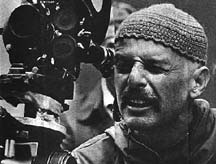|
Vol. 2, Issue #10 June 8th - June 21st, 2007
DVD Review: The Films of Alejandro Jodorowsky
While he may be cinema’s greatest mystic, Jodorowsky is also one of the most brutal and politically incorrect filmmakers of his time; animals (that would be killed for food anyway) were killed and slaughtered for the sake of his disturbing, yet poetic images, naked children populate his landscape, and he doesn’t flinch in showing the brutal side of human relationships, especially rape, often as a doorway to spiritual awakening.
Unfortunately the film bombed as a regular release. Lennon went on to fund “The Holy Mountain,” but a disagreement between Jodorowsky and Klein cause Klein to pull both films from the U.S. market “forever.” Luckily, the two men have finally made up and both films are back in the mix as DVDs. “El Topo” stands as a gigantic work of experimental film. The title character, played by Jodorowsky, is a leather clad gunman who rides through the desert to encounter and disembowel gay bandits, shoot master gunfighters who refuse to fight, drink from phallic rock fountains that give water, and to rescue a group of maimed and disfigured humans who are trapped in a mountain, only to see them slaughtered by the ruling class. The film features little dialogue, but the silence is filled with the sounds of goats, Sufi horns, and other disturbing noises. The framing and cinematography are both as startling as the images are repulsive.
Both films are available separately, but the box set also includes a short color film, “La Cravate” (1957) about a woman who can interchange people’s heads, and his 1968 film “Fando Y Liz,” about a woman who cannot walk and her boyfriend who pushes her on a cart across the desert and though mountains to find the mythical lost city of Tar. The box also includes CD soundtracks to “El Topo “ and “The Holy Mountain,” and all three feature films include extensive commentary by Jodorowsky subtitled in English. Like “El Topo,” Jodorowsky was an underground cinema bandit who fought his way to Master status of experimental film. His unique vision is well worth exploring. |
||
©2007 NONCO Media, L.L.C.

 Jodorowsky is one of the great visionaries of cinema. His work is often compared to the movies of Luis Buñuel for their surrealism, Sergio Leone for their violent spirituality, and Kenneth Anger for their mesmerizing beauty, but Jodorowsky’s low-budget, desert dreamscape is much more complex and hypnotic than all of the above; a Zen gunfighter cannot be killed because he allows the bullets to pass through his body, birds fly out of the fatal gunshot wounds of the dead, and a man pays a child prostitute by taking out his left eye and placing it in her hand.
Jodorowsky is one of the great visionaries of cinema. His work is often compared to the movies of Luis Buñuel for their surrealism, Sergio Leone for their violent spirituality, and Kenneth Anger for their mesmerizing beauty, but Jodorowsky’s low-budget, desert dreamscape is much more complex and hypnotic than all of the above; a Zen gunfighter cannot be killed because he allows the bullets to pass through his body, birds fly out of the fatal gunshot wounds of the dead, and a man pays a child prostitute by taking out his left eye and placing it in her hand. The main reason Jodorowsky has remained in obscurity is because his two masterworks, “El Topo” (“The Mole,” 1970) and “The Holy Mountain” (1973,) have only been available in the U.S. as bootlegs until this month. “El Topo” originally opened as a midnight feature at the Elgin Theater in New York in 1970 and played to sell out crowds for a year and a half, thus becoming the first true “Midnight Movie.” John Lennon was so impressed by the film that he had The Beatles’ manager, Alan Klein, buy the rights to distribute it to regular theaters and had the soundtrack released on Apple records.
The main reason Jodorowsky has remained in obscurity is because his two masterworks, “El Topo” (“The Mole,” 1970) and “The Holy Mountain” (1973,) have only been available in the U.S. as bootlegs until this month. “El Topo” originally opened as a midnight feature at the Elgin Theater in New York in 1970 and played to sell out crowds for a year and a half, thus becoming the first true “Midnight Movie.” John Lennon was so impressed by the film that he had The Beatles’ manager, Alan Klein, buy the rights to distribute it to regular theaters and had the soundtrack released on Apple records.  “The Holy Mountain” is even more amazing. Two nude women have their heads shaved by a man in a large hat, the Christ-figure/Tarot fool is awaken from his cross by naked boys throwing rocks at him, the bloody battle of the Incas and the Spanish is played out with frogs and lizards dressed as the respective armies, who are then literally blown up, and the Mary Magdalene figure is first seen with a group of prostitutes and a chimp all staring at a statue that is weeping blood. From there the film becomes a bloody and non-sequential metaphor of the Tarot deck.
“The Holy Mountain” is even more amazing. Two nude women have their heads shaved by a man in a large hat, the Christ-figure/Tarot fool is awaken from his cross by naked boys throwing rocks at him, the bloody battle of the Incas and the Spanish is played out with frogs and lizards dressed as the respective armies, who are then literally blown up, and the Mary Magdalene figure is first seen with a group of prostitutes and a chimp all staring at a statue that is weeping blood. From there the film becomes a bloody and non-sequential metaphor of the Tarot deck.